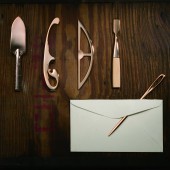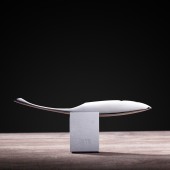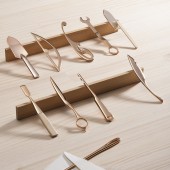
| THE AWARD |
| CATEGORIES |
| REGISTRATION |
| SUBMIT YOUR WORK |
| ENTRY INSTRUCTIONS |
| TERMS & CONDITIONS |
| PUBLICATIONS |
| DATES & FEES |
| METHODOLOGY |
| CONTACT |
| WINNERS |
| PRESS ROOM |
| GET INVOLVED |
| DESIGN PRIZE |
| DESIGN STORE |
| THE AWARD | JURY | CATEGORIES | REGISTRATION | PRESS | WINNERS | PUBLICATIONS | ENTRY INSTRUCTIONS |
Memento Letter Opener by Bryan Leung |
Home > Winners > Design #49675 >Interview |
 |
|
FS: What is the main principle, idea and inspiration behind your design?
BL: The main idea behind my design is to express emotions through gift-giving. The concept originated from me wanting to thank my father for raising me; however, I subsequently learned that many people want to express their emotions (e.g., thanks) to different people
FS: What has been your main focus in designing this work? Especially what did you want to achieve?
BL: The main focus in designing this work is to offer a gift that is able to clearly and effectively express the gift givers’ thoughts and emotions as well as touch the gift receivers’ hearts.
FS: What are your future plans for this award winning design?
BL: I hope that many people can have this design in their possession because it will mean that many people will have successfully expressed their emotions, which will lead to the creation of more stories.
FS: How long did it take you to design this particular concept?
BL: About one year.
FS: Why did you design this particular concept? Was this design commissioned or did you decide to pursuit an inspiration?
BL: This concept was designed to touch people emotionally. I believe that life offers many aspects that can touch people emotionally and that we should show the notion in the form of aesthetics.
FS: What made you design this particular type of work?
BL: I designed this work because I wanted to create a balance between emotions and images
FS: Who is the target customer for his design?
BL: The target customers for this design are people who wish to express their emotions or ideas to other people in a tasteful way.
FS: How did you come up with the name for this design? What does it mean?
BL: This design means recollections, memories, and commemorations.
FS: Which design tools did you use when you were working on this project?
BL: I used semiotics, product semantics, and cognitive psychology when working on this project.
FS: What is the most unique aspect of your design?
BL: The most unique aspect of my design involves adding “emotions” to letter openers by designing them with distinctive unique appearances. This allows gift recipients to receive not only visually attractive letter openers, but also the thoughts and emotions expressed by gift givers. Each letter opener is polished and refined by a master craftsman to enable the shape of the surface of the desktop tool to ooze a warm and touching feeling. In addition, each letter opener is slightly different in shape from others.
FS: Who did you collaborate with for this design? Did you work with people with technical / specialized skills?
BL: I worked with polishing and casting masters to develop this design.
FS: What is the role of technology in this particular design?
BL: Technology helped me elevate my ideas and product texture to a higher level and, most importantly, it allowed an ice-cold material to evoke a sense of warmth.
FS: Is your design influenced by data or analytical research in any way? What kind of research did you conduct for making this design?
BL: I spent a lot of time collecting people’s thoughts on gift recipients and separated the former by its professions. In addition, I explored in-depth the different living and professional work environments of people as well as the thoughts of the general public and myself.
FS: What are some of the challenges you faced during the design/realization of your concept?
BL: Some of the challenges that I faced during the design/realization process included selecting the appropriate product appearances as well as finding a balance between my personal ideas and those of the general public. I had to design unique product features for each profession because if the features were too generalized, they would not be able to exemplify the professions. However, if they were too intricate, people would not be able to recognize the professions represented. Another challenge that I faced was finding a balance between mechanical and abstract product appearances, because product appearances that were too mechanical would lose their imagination-based appeal, whereas those that were too abstract would be too difficult to understand.
FS: How did you decide to submit your design to an international design competition?
BL: I decided to submit my design to the international design competition because I wanted to provide people with the opportunity to express their thoughts. In addition, I wanted people to see my designs.
FS: What did you learn or how did you improve yourself during the designing of this work?
BL: I learned that I need to keep trying and make constant revisions so that my designs can reach and benefit different people. By reaching as many people as I can, I will be able to get different responses from them, which will subsequently help me expand my perspectives.
FS: Thank you for providing us with this opportunity to interview you.
A' Design Award and Competitions grants rights to press members and bloggers to use parts of this interview. This interview is provided as it is; DesignPRWire and A' Design Award and Competitions cannot be held responsible for the answers given by participating designers.
| SOCIAL |
| + Add to Likes / Favorites | Send to My Email | Comment | View Press-Release | Translations |




